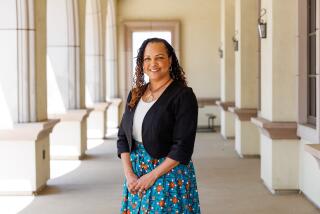New College for Dyslectics Has Excess of Applicants
- Share via
Each semester, it costs $19,500 to send a student to Landmark College in Putney, Vt. No financial aid exists; classes are rugged; the school is not yet accredited, and the campus in winter, according to one Californian, resembles Siberia with less to do.
Yet in its third semester, the two-year residential college has 134 students enrolled--more than its capacity--and has had to turn away half the applicants, according to Landmark College President James Oliver, who spoke last week to three dozen parents of prospective students and supporters in a Newport Beach home.
The reason is that the college is the nation’s only institution of higher learning devoted exclusively to dyslectics.
Landmark College represents the “Cadillac of programs offered for dyslectics at the college level,” said Joan McNichols, president of the Orange County branch of the Orton Dyslexia Society, a nonprofit support and advocacy group, which sponsored Oliver’s talk, along with the Newport Community School, a Costa Mesa elementary school for dyslectics now in its first year of operation.
Dyslexia, also known as a reading or learning disability, is a permanent neurological disorder. It affects an estimated 15% of the population regardless of intelligence or sociocultural opportunities.
Researchers have identified five types of dyslexia, said McNichols. The types are: dyslexia (reading and spelling errors such as mistaking “was” for “saw”); dyscalculia (the inability to calculate numbers such as mileage, time or change); dysgraphia (the inability to write even though the mind is full of ideas); dysnomia (inability to remember names of things such as months of the year, days of the week or people). A fifth group suffers from dyslexia-plus, the language disabilities plus an attention disorder, either hypo- or hyperactivity.)
Parents attending the meeting said their children’s invisible handicaps made their elementary and secondary schooling a nightmare of teachers’ rebukes and self-doubt.
Paradoxically, the brain defect, thought to occur during fetal development, may cause other areas of the brain to be enhanced thus producing in some dyslectics extraordinary talents along with liabilities, say experts. One Landmark student had spent his elementary years in both the gifted and handicapped programs, Oliver said.
“A very high percentage of those who get into college have dyslexia,” said McNichols. “They often have high scores in math. But they simply cannot handle reading and writing at a college level.”
Some Landmark students such as Mark Spencer, 23, of Fullerton, were told as children that they would “grow out” of their reading problems. “I can guarantee that’s not true,” he told the group last week. Even with a series of private tutors, he said, it took “everything I had” to barely pass his elementary and high school classes.
Though athletic and popular, Spencer felt that he had let his parents down, he said, since his older brother had straight A’s through business and law school.
After graduation from Troy High School in Fullerton, he tried several community colleges and became an expert at dropping classes each time he realized he would not pass. Even in football, he drifted to second and third string, then dropped the sport altogether because he had to read and study the playbooks, not just listen to the coach. Eventually he gave up college and started his own auto detailing business.
But last August, his father, Charles Spencer, a Fullerton psychiatrist, saw a Mobil Oil ad that featured information on Landmark College. Mark applied and was accepted at the last minute. He took entrance tests at Landmark West, a separate school for dyslectic first- through eighth-graders in Culver City.
Since Mark had never been labeled dyslectic, he wondered what a school of dyslectics would be like. He said his “imagination ran wild” picturing a campus of nerds and misfits.
Instead, he found friends like himself--prolific storytellers who shared familiar tales such as how they avoided tests by acting up in class and getting kicked out. Some had enrolled right out of high school. Some were as old as 27.
A student body of dyslectics is not a problem but an asset, Oliver said. “They are probably less prone to drugs and alcohol. They are really motivated. They’re not here to experiment with life styles. They’re here to learn.”
Landmark College students are 80% male, a situation that brings complaints from the men students, Oliver said. Dyslexia is thought to strike more men than women, though some have argued it is easier for women dyslectics to hide their problems with verbal abilities. Oliver said Landmark is trying to recruit more women.
Landmark College applicants--all diagnosed dyslectics--must have average or above average intelligence (as determined by a variety of tests), a lack of significant emotional problems and a demonstrated commitment to improve, “the toughest thing to identify in advance,” Oliver said.
No SAT tests are required at Landmark. Neither SATs nor IQ tests alone can determine what a dyslectic can accomplish, Oliver said. One student’s IQ score--generally thought to remain static--increased from the time he enrolled to the time he left, he said.
The college uses a simultaneous, multisensory language training method designed especially for dyslectics to build their skills rather than bypass the problem with tape recorders and oral exams, Oliver said. “We feel the students have to learn (reading and writing). You can’t get a taped memo of what your boss wants done.”
Those whose skills have not reached the upper high school level enroll in a pre-college program where training is given though one-to-one tutorials. The 1-2.5 student-teacher ratio accounts for the nonprofit college’s high tuition, Oliver said.
Students remain in pre-college anywhere from one semester to “as long as it takes,” he said. When they are ready, they may start taking standard liberal arts classes with continued writing and organizing training at Landmark College, where the largest class has 14 students. Many are able to transfer to other colleges where Landmark’s credits are accepted, he said.
About 100 of the 134 students are enrolled in the pre-college.
“It’s a very intensive program. It’s not uncommon for students to spend three to five hours at night studying. One of the keys to progress is you have to work hard to be successful. Students are held accountable for their work daily,” Oliver said.
Behind the toughness lies tender personal and professional support from tutors, supervisors or resident advisers in the dorms, he said. All faculty members are trained by specialists in dyslexia. About five are dyslectics themselves, a number proportionate to the general population, Oliver said.
“They try to build up the idea that good-timers need not apply,” Mark Spencer said. “For myself, having had so much failure in school, I worried I wouldn’t be able to handle this either. But they work into it gradually, there’s so much support, the faculty goes out of their way. You have to work at failing.”
At Christmas break, he received a report card for his first semester at Pre-College: a pass in tutorial, and A’s in geology, English, study skills and algebra.
Mark’s parents say his self-esteem has improved. He said he is sometimes frustrated thinking about all the things he still wants to accomplish and worries he might be too old to still be in school. But he knows he has made more advances in four months than in the past three years.
“I have conferences with teachers and they seem to think there’s no problem getting into any school within reason.”
Even though the college is full, Oliver said he is recruiting high-potential dyslectics to fill the slots that open up when students leave. And he hopes to expand.
“There is a need,” Oliver said. “It’s hard to turn people like Mark down.”
The affluent parents attending the meeting said the steep tuition did not matter to them, but others have mortgaged their homes so their children could attend, Oliver said.
The college has taken every step possible to become an official candidate for accreditation--a requirement for federal financial assistance, Oliver said. In addition, the college has given a high priority to raising funds for its own scholarships.
“When I think of the people who can’t afford it, it makes me cry,” said Nan Strauch of South Laguna whose husband Charles is a member of the Landmark College board of trustees. Their son Charlie, 21, is in pre-college.
“Miracles happen on that campus,” she said.
SYMPTOMS OF DYSLEXIAExamples of work by dyslexic children.Dyslexics often have some of the following symptoms, said Judith Moulding Adelson, a West Los Angeles educational therapist specializing in the treatment of dyslexics.
Consider themselves stupid.
Appear to be lazy.
Easily get bored and distracted.
Exhibit clumsiness.
Show reluctance take on new challenges.
Frequently pick fights.
See and write reversed numbers and letters. (“Was” for “saw” and (&) for 7.)
Incorrectly follow a series of directions. (Omit some, or do them in wrong order.)
Exhibit a large discrepency between math and verbal ability, doing well in one or the other, but not both.
Commmunicate well verbally but badly in writing.
Appear to make frequent careless errors.
Have difficulty remembering what they hear and what they see at the same time.
Have difficulty following directions.
Have difficulty copying written information.
Have messy handwriting that does not stay within margins.
Misspell easy words.
Try to gain attention by being the class clown in school.
More to Read
Sign up for Essential California
The most important California stories and recommendations in your inbox every morning.
You may occasionally receive promotional content from the Los Angeles Times.










